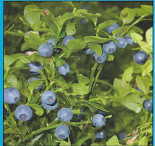The ascent of mountains in late July was central to the ancient rituals associated with the Festival of Lughnasa. Máire Mac Neill studied almost 200 sites believed to be associated with that event, including Croagh Patrick, in an attempt to build up a picture of what used to happen in pre-Christian times.
It may have had its origin in a mythological struggle between the gods Crom Dubh and Lugh for possession of the harvest. The human customs that followed ranged from the collection of bilberries to the sacrifice of a bull and some of these continued into relatively modern times. O' Neill quotes an example from Kilkenny in 1942 where the young men of a district climbed a hill (Brandon Hill?) to collect the fraughans that were then presented to young women to make 'Fraughan Cake' after which they danced at the Bonfire into the early hours.
 |
| Fraughans |
 |
| Fraughan bush. |
In Kerry, the slopes of The Paps was the place that huge crowds gathered to celebrate Lughnasa and pick the wild fruits. In Ulster crowds climbed the steep slopes of Sliabh Croob to the Twelve Cairns on 'blaeberry Sunday' and Tobar na Sul on Sliabh Snaght in Inishowen was where the festival was celebrated on 'Heatherberry Sunday'.
There were similar celebrations on high places in many other parts of the country: Blackstairs (Caher Roe's Den), Slieve Blooms (Ard Eireann, Ridge of Capard), Tory Hill, Slieve Donard, Slieve Snaght and many others. As Máire MacNeill says 'to know that every year it had been the custom of our ancesters to assemble on these hills in festivity and high spirits...is to understand better Irish history, our passion for the wide land, for place-lore...'
It is clear that this was another reason for people to go into the mountains and uplands - an activity that continued well into the 20th C. in modern times such festivals may have faded away but the enjoyment of the uplands and mountains remains, as indicated by the level of participation in hiking and hillwalking.
See: Picking Bilberries, Fraocháins and Whorts in Ireland, by Michael J. Conry for a definitive account of this activity.
Thanks also to: Frank McNally, Irish Times, July26 2019.
Go to Home for full site map



No comments:
Post a Comment